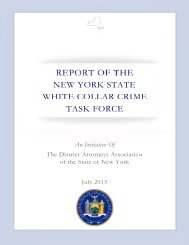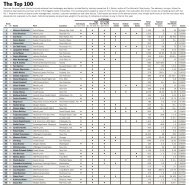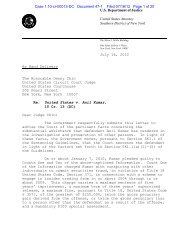Salz Review - Wall Street Journal
Salz Review - Wall Street Journal
Salz Review - Wall Street Journal
You also want an ePaper? Increase the reach of your titles
YUMPU automatically turns print PDFs into web optimized ePapers that Google loves.
<strong>Salz</strong> <strong>Review</strong><br />
An Independent <strong>Review</strong> of Barclays’ Business Practices<br />
134<br />
the enormous growth in investment bank top-line revenue, the ‘commission’ mindset<br />
(whereby a small percentage of a large number gets allocated to the producer)<br />
leads to very high pay awards. It had become difficult, they said, to determine what<br />
the appropriate share should be. So while there might be an intellectual case for<br />
paying exceptional performers handsomely (the so-called ‘stars’ or ‘rain-makers’),<br />
there seems to be little logic for the inflationary trickle down to less exceptional<br />
colleagues. One interviewee observed that the scandal of banker pay was less that of<br />
the star performer, but of the mediocre banker who, under the umbrella of a star and<br />
benefiting from the franchise of a top investment bank, received disproportionate<br />
reward simply for being there.<br />
11.18 Total compensation at Barclays was over £10 billion in 2010 and 2011, and<br />
£9.8 billion in 2012. Of this £3.5 billion was paid out as incentive pay in 2010,<br />
£2.6 billion in 2011 and £2.4 billion in 2012. Total compensation has come down<br />
since pre-crisis levels, most notably in the investment bank where average salary plus<br />
bonus per employee in 2012 was down 30% over 2007 (having been higher than<br />
2007 in three of the four succeeding years). On average, in both the investment and<br />
retail banks, compensation levels for most roles in Barclays have been in line with<br />
peers. The exception to this is the Group’s 70 or so most senior or highly-paid<br />
executives. 210<br />
11.19 Compensation for the ‘group of 70’ was consistently and significantly above the<br />
median compared to peer banks. For example, in 2010 average pay to these<br />
executives was overall 35% more than the market benchmark for their positions.<br />
This level has come down over the past two years. In 2011 average pay for these<br />
executives was 17% more than the market. 211 Pay in excess of benchmarks was in<br />
large part caused by several senior staff transferring from the investment bank to<br />
different, less well-paid roles, without adjustment in pay to reflect the ‘going rate’ for<br />
the new position. It is likely that these movements themselves had a ripple effect on<br />
other packages – with the result that in different parts of the bank Barclays was<br />
paying different rates for the same job – including paying well over the going rate for<br />
some positions. We recognise that moving individuals around the Group may result<br />
in those individuals receiving above-market compensation for a particular role for a<br />
period of time, but the knock-on effects seem inappropriate. In general we are<br />
supportive of increased mobility of senior executives across the Group (see<br />
Recommendation 20). Having substantially the same rates for essentially similar<br />
jobs will assist mobility.<br />
11.20 One of the difficulties surrounding the debate about bankers’ pay is that there is no<br />
shared view of how to divide the pie between owners and employees – particularly<br />
given the difficulty of distinguishing individual contribution from the umbrella value<br />
of the franchise.<br />
210 For the purposes of the report we defined this group as including Executive Committee members in<br />
Group, RBB, WIM and CIB; IB employees earning more than £5m; and any employees in RBB, WIM<br />
and CB who are one of the top ten highest earners in their business unit but are not on the Executive<br />
Committee. This group received the most scrutiny from the Board Remuneration Committee, and the<br />
number of executives varied slightly year on year.<br />
211 Benchmark data for 2012 was not yet available to make a similar comparison for the most recent financial<br />
year.
















